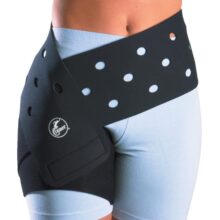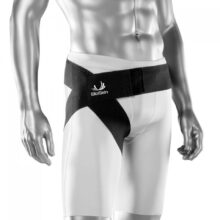Groin Hip Spica
Se connecter pour obtenir les prix des revendeurs
Designed to wrap groin strains, hip abductors and flexor strains
A groin strain is an injury caused by tearing or overstretching of one or more of the groin or thigh muscles (specifically, the adductor muscles of the inner thigh), resulting in pain in the inner thigh area.
This injury is often caused by running, jumping or making a sudden change in direction. It is frequently observed among hockey, rugby and soccer players.
Typical symptoms of a groin strain are a popping or snapping feeling at the time of the rupture followed by pain and swelling in the groin area.
Groin strains are typically treated at home by resting and icing the injured area. A groin/hip spica support can be effective in immobilizing the injured structures and allowing them to rest in order to assure a full recovery. An important part of the recovery process is physical rehabilitation through participation in a groin strain rehab program.
The time required to recover from a groin strain depends on several factors, including the severity of the injury and the fitness level of the injured individual. However, one should expect to need several weeks to fully recover from this injury and return to regular activities.
Although it is sometimes said that groin strain injuries can contribute to erectile dysfunction, there is in fact no evidence of this.
As stated above, this injury is strongly associated with sporting or athletic activities. Most affected individuals tend to be either professional or recreational athletes.
Probably the most frequently observed cause of groin strains is damage to the adductor muscles while performing a kicking movement.
Probably the next most frequently observed cause is trying to execute a turn while also running, skating or jumping.
Generally speaking, any movement that requires simultaneous lengthening and contraction of groin muscles elevates the risk of a strain.
Other than sports, the activities that can cause this type of injury include:
The primary factors that increase the risk of experiencing a groin strain are:
As with other types of sprain or strain, the severity of any groin muscle strain can be placed into one of three categories:
In many cases, people with groin strains report hearing or sensing a snapping or popping sound at the time the injury is sustained.
Other typical signs and symptoms of this injury are:
The severity of the pain is usually greater from grade II than grade I injuries, and for grade III compared to II.
To formally diagnose a groin strain, a doctor will usually ask the injured person to explain how the injury occurred (i.e. what were they doing when it happened).
The doctor will also review the patient’s medical history to see whether he/she has suffered previous groin injuries that may predispose them to experiencing a strain.
Most doctors will then conduct a physical examination. Typical components of the exam might include asking the patient to stretch his/her adductor muscles and report whether any groin pain results. The doctor will also likely test the range of motion of the injured leg.
Most grade I and II groin strains can be treated successfully using the R.I.C.E. protocol:
If the pain is severe, the doctor can also prescribe non steroidal inflammatory medicine for pain relief.
Physical therapy exercises (which we describe next) are an important part of the recovery process.
These are strengthening exercises for the groin and inner thigh. They will also help to increase the flexibility of adductor muscles, making them less usceptible to another strain.
Examples include:
This will obviously depend on the severity of the injury as well as whether the individual receives proper treatment and follows the doctors recommendations. Another important factor is the physical fitness of the injured person. The higher his/her fitness level, the shorter the recovery period, ceteris paribus.
Having said this, approximate recovery periods for a groin strain injury might be 2-3 weeks for a grade I strain, 2-3 months for a grade II strain and at least 4 months for a grade III injury.

Se connecter pour obtenir les prix des revendeurs
Designed to wrap groin strains, hip abductors and flexor strains

Se connecter pour obtenir les prix des revendeurs